GaAs-Based InPBi Quantum Dots for High Efficiency Super-Luminescence Diodes
Abstract
1. Introduction
2. Results and Discussions
2.1. Strain Analysis
2.2. Band Structure
3. Methods
| acεhy | 0 | −v* | 0 | −3½v | 2½u | u | −2½v* | (3) | |
| 0 | acεhy | 2½u | 3½v* | 0 | v | −2½v | −u | ||
| −v | 2½u | −P + Q | −s* | r | 0 | 1.5½s | −2½q | ||
| 0 | 3½v | -s | −P − Q | 0 | r | −2½r | s/2½ | ||
| Hs = | −3½v* | 0 | r* | 0 | −P − Q | s* | s*/2½ | 2½r* | |
| 2½u | v* | 0 | r* | s | −P + Q | 2½q | 1.5½s* | ||
| u | −2½v* | 1.5½s* | −2½r* | s/2½ | 2½q | -avεhy | 0 | ||
| −2½v | −u | −2½q | s*/2½ | 2½r | 1.5½s | 0 | −avεhy |
4. Conclusions
Author Contributions
Funding
Conflicts of Interest
References
- Alberi, K.; Wu, J.; Walukiewicz, W.; Yu, K.M.; Dubon, O.D.; Watkins, S.P.; Furdyna, J. Valence-band anticrossing in mismatched III-V semiconductor alloys. Phys. Rev. B 2007, 75, 045203. [Google Scholar] [CrossRef]
- Fluegel, B.; Francoeur, S.; Mascarenhas, A.; Tixier, S.; Young, E.C.; Tiedje, T. Giant spin-orbit bowing in GaAs 1− x Bi x. Phys. Rev. Lett. 2006, 97, 067205. [Google Scholar] [CrossRef] [PubMed]
- Francoeur, S.; Adamcyk, M.; Tiedje, T. Band gap of GaAs1-xBix, 0 < x < 3.6%. Appl. Phys. Lett. 2003, 82, 3874–3876. [Google Scholar]
- Wang, K.; Gu, Y.; Zhou, H.F.; Zhang, L.Y.; Kang, C.Z.; Wu, M.J.; Wang, S.M. InPBi Single Crystals Grown by Molecular Beam Epitaxy. Sci. Rep. 2014, 4, 5449. [Google Scholar] [CrossRef] [PubMed]
- Kopaczek, J.; Kudrawiec, R.; Polak, M.P.; Scharoch, P.; Birkett, M.; Veal, T.D.; Wang, S. Contactless electroreflectance and theoretical studies of band gap and spin-orbit splitting in InP1−xBix dilute bismide with x ≤ 0.034. Appl. Phys. Lett. 2014, 105, L1283. [Google Scholar] [CrossRef]
- Wu, X.; Chen, X.; Pan, W.; Wang, P.; Zhang, L.; Li, Y.; Wang, S. Anomalous photoluminescence in InP1−xBix. Sci. Rep. 2016, 6, 27867. [Google Scholar] [CrossRef] [PubMed]
- Huang, D.; Swanson, E.A.; Lin, C.P.; Schuman, J.S.; Stinson, W.G.; Chang, W.; Puliafito, C.A. Optical coherence tomography. Science 1991, 254, 1178–1181. [Google Scholar] [CrossRef] [PubMed]
- Zhang, L.; Wu, M.; Chen, X.; Wu, X.; Spiecker, E.; Song, Y.; Wang, S. Nanoscale distribution of Bi atoms in InP 1−x Bi x. Sci. Rep. 2017, 7, 1. [Google Scholar]
- Zhang, L.; Song, Y.; Chen, Q.; Zhu, Z.; Wang, S. InPBi Quantum Dots for Super-Luminescence Diodes. Nanomaterials 2018, 8, 705. [Google Scholar] [CrossRef] [PubMed]
- Pan, W.; Zhang, L.; Zhu, L.; Song, Y.; Li, Y.; Wang, C.; Wang, S. Photoluminescence of InGaAs/GaAsBi/InGaAs type-II quantum well grown by gas source molecular beam epitaxy. Semicond. Sci. Technol. 2016, 32, 1. [Google Scholar] [CrossRef]
- Pan, W.; Zhang, L.; Zhu, L.; Li, Y.; Chen, X.; Wu, X.; Wang, S. Optical properties and band bending of InGaAs/GaAsBi/InGaAs type-II quantum well grown by gas source molecular beam epitaxy. J. Appl. Phys. 2016, 120, 094011. [Google Scholar] [CrossRef]
- Pan, W.; Wang, P.; Wu, X.; Wang, K.; Cui, J.; Yue, L.; Wang, S. Growth and material properties of InPBi thin films using gas source molecular beam epitaxy. J. Alloys Compd. 2016, 656, 777–783. [Google Scholar] [CrossRef]
- Rajpalke, M.K.; Linhart, W.M.; Birkett, M.; Yu, K.M.; Alaria, J.; Kopaczek, J.; Veal, T.D. High Bi content GaSbBi alloys. J. Appl. Phys. 2014, 116, 043511. [Google Scholar] [CrossRef]
- Kuo, C.P.; Vong, S.K.; Cohen, R.M.; Stringfellow, G.B. Effect of mismatch strain on band gap in III-V semiconductors. J. Appl. Phys. 1985, 57, 5428–5432. [Google Scholar] [CrossRef]
- Chuang, S.L. Physics of Photonic Devices; John Wiley & Sons: Hoboken, NJ, USA, 2012. [Google Scholar]
- Kim, K.; Hart, G.L.W.; Zunger, A. Negative band gap bowing in epitaxial InAs/GaAs alloys and predicted band offsets of the strained binaries and alloys on various substrates. Appl. Phys. Lett. 2002, 80, 3105–3107. [Google Scholar] [CrossRef]
- Vurgaftman, I.; Meyer, J.; Ram-Mohan, L. Band parameters for III–V compound semiconductors and their alloys. J. Appl. Phys. 2001, 89, 5815–5875. [Google Scholar] [CrossRef]
- Sytnyk, D.; Melnik, R. The Luttinger-Kohn theory for multiband Hamiltonians: A revision of ellipticity requirements. arXiv 2018, arXiv:1808.06988. [Google Scholar]
- Cicek, B.; Sánchez-Pérez, J.R.; Cavallo, F.; Lagally, M.G.; Paiella, R. Strained-germanium nanostructures for infrared photonics. ACS Nano 2014, 8, 3136–3151. [Google Scholar]
- Chen, X.; Wu, X.; Yue, L.; Zhu, L.; Pan, W.; Qi, Z.; Shao, J. Negative thermal quenching of below-bandgap photoluminescence in InPBi. Appl. Phys. Lett. 2017, 110, 051903. [Google Scholar] [CrossRef]
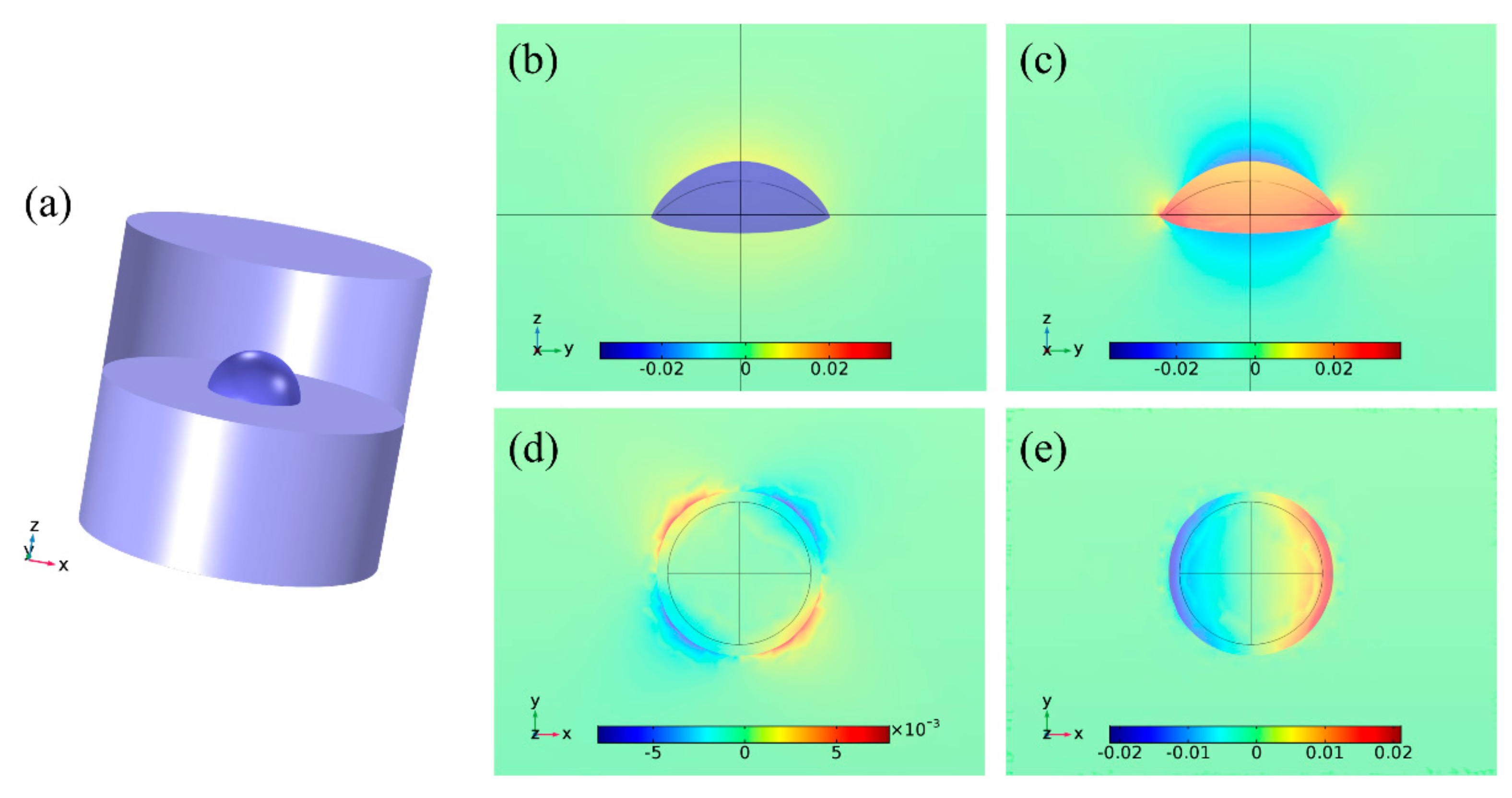

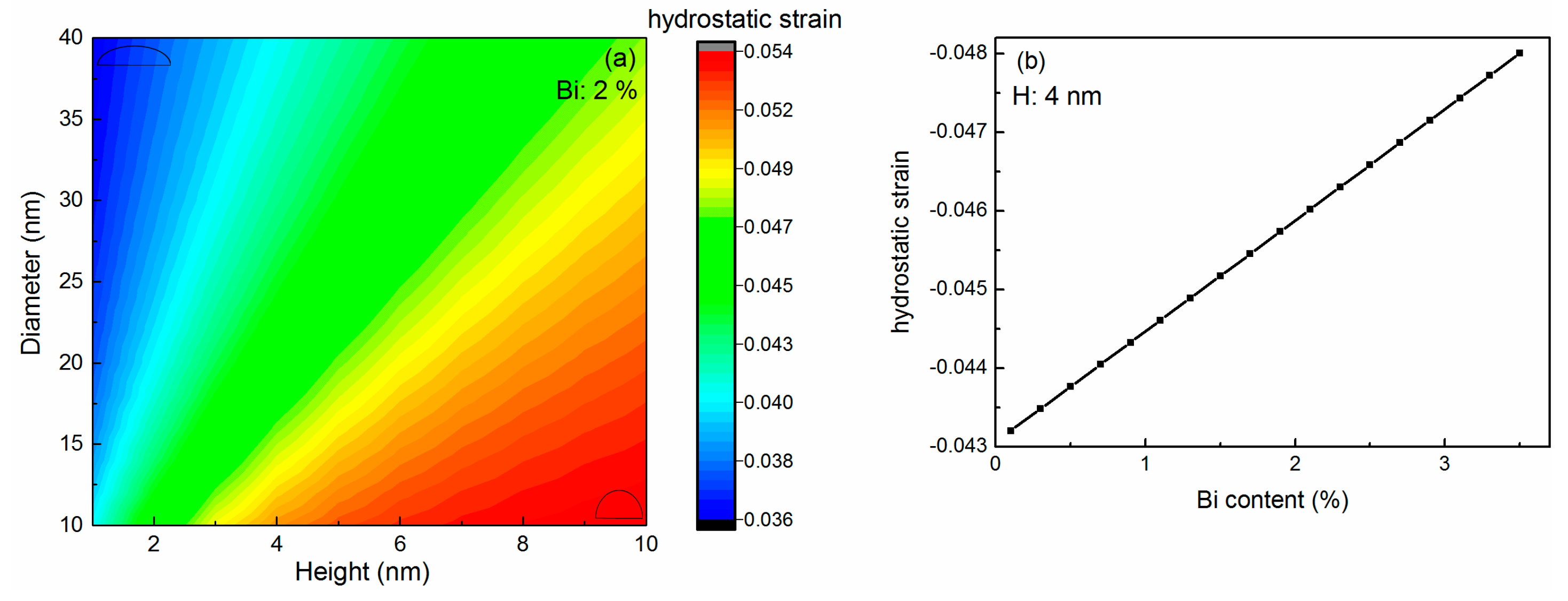
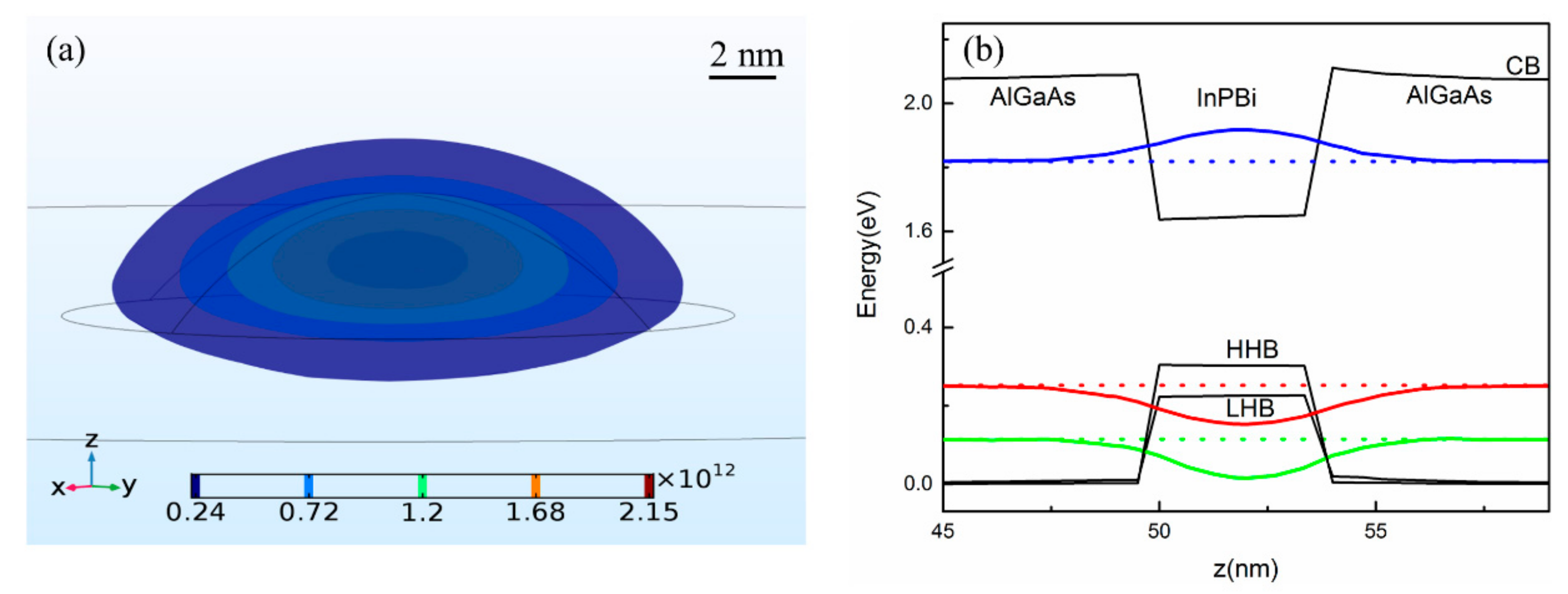
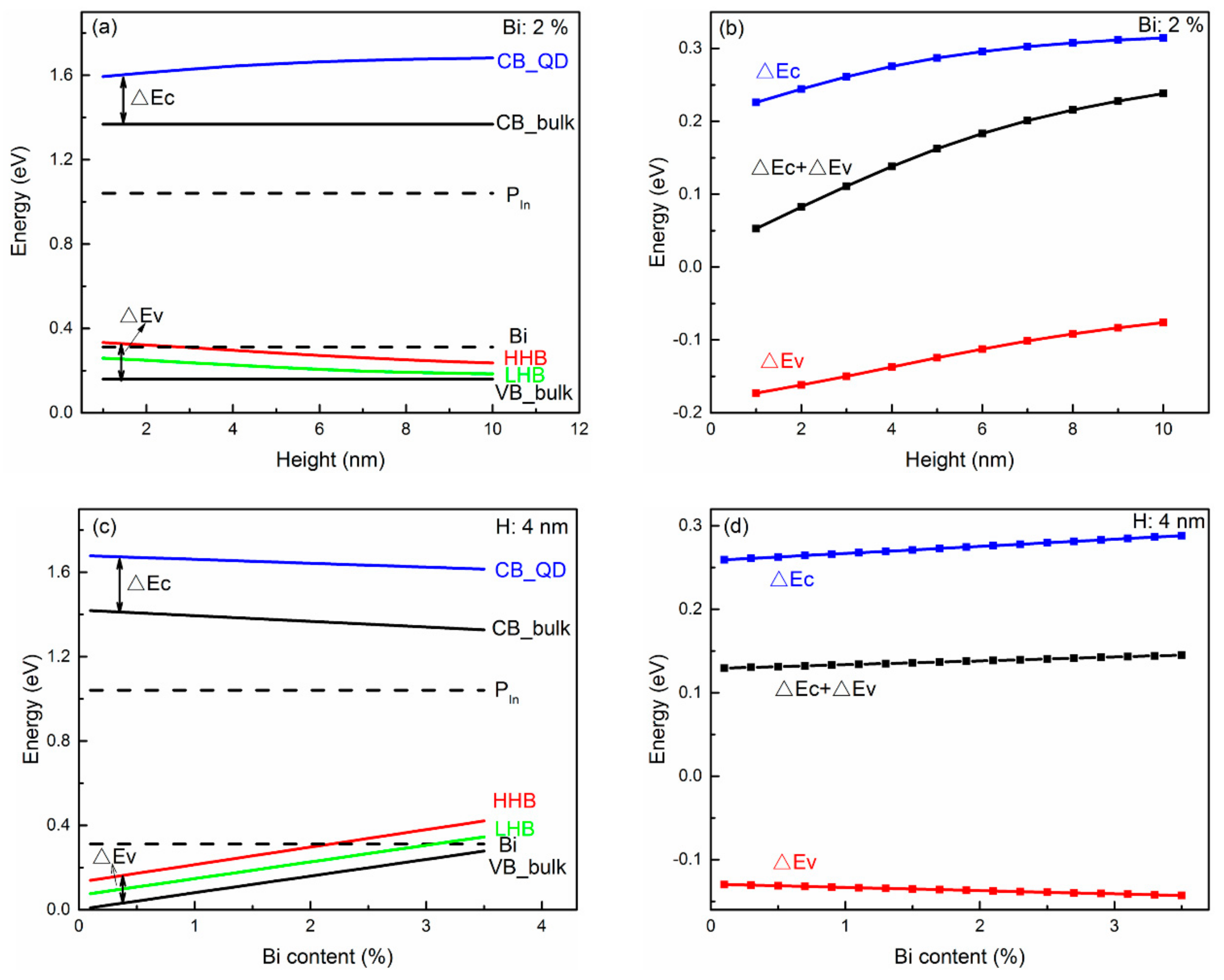
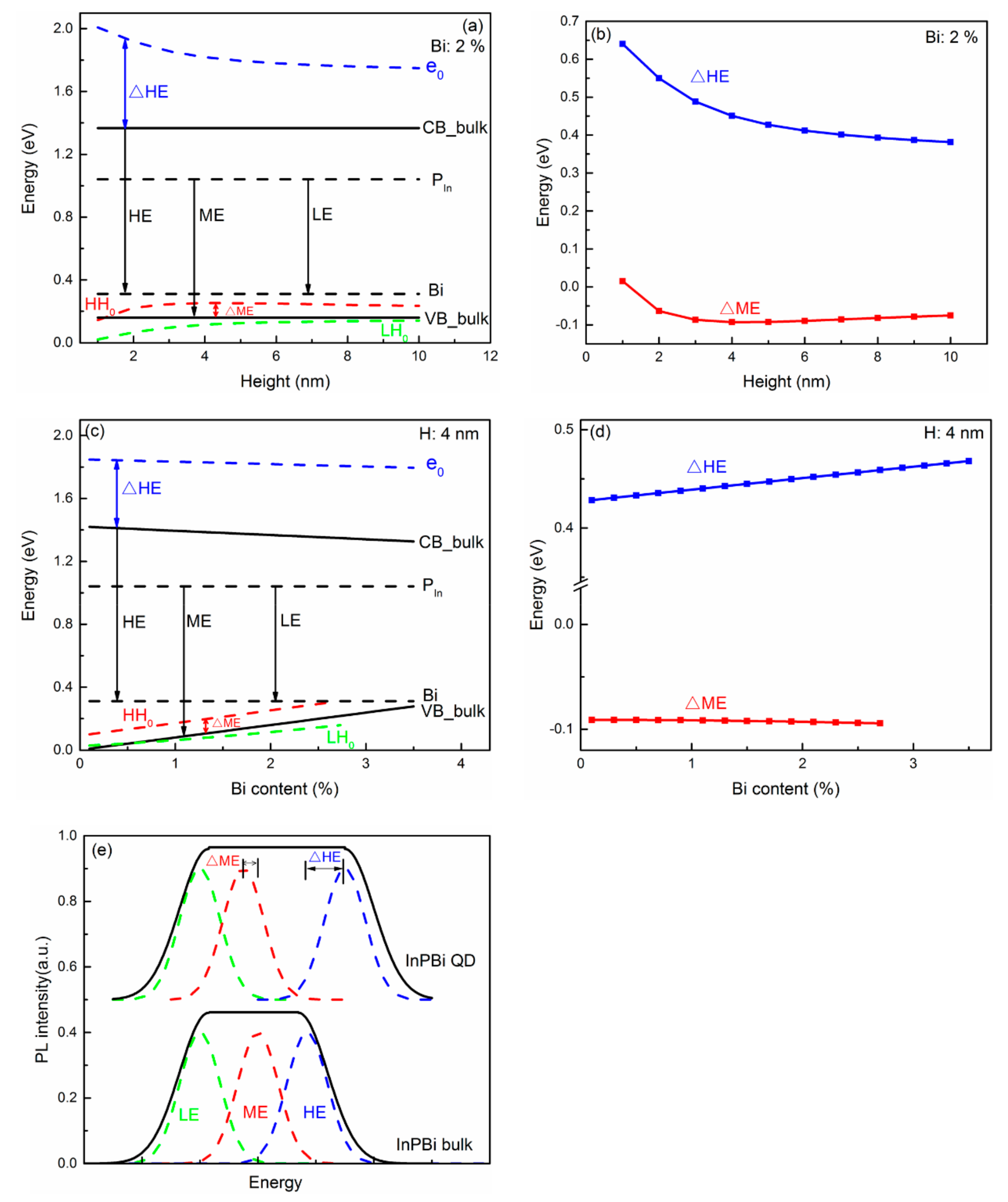
| Parameters | InP1-xBix [17] | Al0.42Ga0.58As [17] |
|---|---|---|
| C11 (GPa) | 1011(1 − x) + 60.31x | 1233.2 |
| C12 (GPa) | 561(1 − x) + 32.52x | 552.56 |
| C44 (GPa) | 456(1 − x) + 26.1x | 576.64 |
| ac (eV) | −6 | −6.53 |
| av (eV) | −0.6 | −1.71 |
| b (eV) | −2 | −2.13 |
| Δ(eV) | 0.108 + 0.7x [5] | 0.32 |
| m | 0.0795 m0 | 0.098 m0 [20] |
| m | 0.6 m0 | 0.615 m0 [20] |
| m | 0.089 m0 | 0.11 m0 [20] |
© 2019 by the authors. Licensee MDPI, Basel, Switzerland. This article is an open access article distributed under the terms and conditions of the Creative Commons Attribution (CC BY) license (http://creativecommons.org/licenses/by/4.0/).
Share and Cite
Zhang, L.; Song, Y.; Gong, Q. GaAs-Based InPBi Quantum Dots for High Efficiency Super-Luminescence Diodes. Int. J. Mol. Sci. 2019, 20, 6001. https://doi.org/10.3390/ijms20236001
Zhang L, Song Y, Gong Q. GaAs-Based InPBi Quantum Dots for High Efficiency Super-Luminescence Diodes. International Journal of Molecular Sciences. 2019; 20(23):6001. https://doi.org/10.3390/ijms20236001
Chicago/Turabian StyleZhang, Liyao, Yuxin Song, and Qian Gong. 2019. "GaAs-Based InPBi Quantum Dots for High Efficiency Super-Luminescence Diodes" International Journal of Molecular Sciences 20, no. 23: 6001. https://doi.org/10.3390/ijms20236001
APA StyleZhang, L., Song, Y., & Gong, Q. (2019). GaAs-Based InPBi Quantum Dots for High Efficiency Super-Luminescence Diodes. International Journal of Molecular Sciences, 20(23), 6001. https://doi.org/10.3390/ijms20236001





